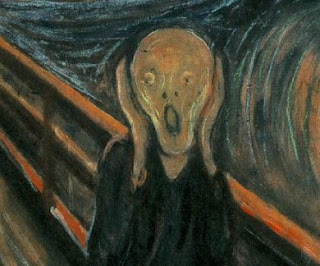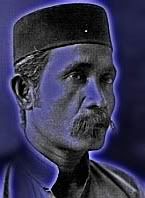He walks the cat walk and talks to strangers and fisherfolk.
 Kucing bapök
Kucing bapök he is called, or Father Cat, which, as cats go, are derisory words, as they give him a bad name among
kampong folk. He's got eyes only for the ladies, they say, and he is known to be vociferous in the freshness of the morn when half the
kampong are still in bed nursing the thought of another day away from work. His language is crass and his coat’s badly in need of a brush, and is full of dirt and debris caught while rolling in the dust with another cat. It was over a female cat, or a disputed patch, he isn’t sure now as his cat-diary and memory were strewn about and got lost in the fight.
Cat-speak raised in anger is
kkarak, but cat-fight is never
ggöcöh but
ggömö.
He has feathers in his hair from his travels in the dark beneath a house, and cobwebs still dangle from unwieldy whiskers from his visit to the
gök for the morning eggs — raw, if you please — for a cat’s breakfast amid the hullabaloo all about him that sent the mother hens into a cacophony of
kketök.

His parts are thought to be therapeutic and good for the hypertensive (and those with surplus sugar in the blood), but you’ll have to dunk his whiskers, but not his beard, in a bowl of hot water for that.
Kucing korèng he is sometimes called, because his face is due for a wash. Sometimes, when the moon is right, he sits and wails at nothing in particular, and hisses at the passing traffic of little boys walking home from their Qur’an class at night, and then scratches anyone who pokes a stick into his belly of fat.
His coat is grey with mackerel lines, and he likes fish heads for supper, still dripping in blood from the throwaway bin of
kerepok makers. He speaks when his mouth is full, mostly expressions of abuse at other cats in the sideline who are trying to get into the act, but
kucing bapök keeps saying to them, "Grrrrrrr, grrrrr", and "*@&!!+*!" and many things besides. Cats with such dark pastel marks on their fur are sometimes called
kucing cicök, and they resemble tigers with their puffed-up cheeks and eyes that are reputed to see in the dark, and when he sleeps he doesn’t roar but he purrs.
He goes to market to snatch some meat, and then jumps onto rooftops and steals through an opening beneath the thatch into the kitchen of the village midwife. He reaches for a piece of fish-meat that has been soaking in the night in a chipped
belanga of the house. And then, turning to his side and smelling of fish basted in
lengkuas, he lifts his hind leg to paint a little spray on the wall, his visiting card
A long time ago a cat tried to pull a prank on a Tiger that happened to drop in for a chat. Angered tiger pulled his tail and tied it into a knot. And that, boys and girls, is how Malaysian cats have a stump for a tail and are always burying their poo in your back garden, in case Big Tiger gets a whiff their whereabouts.
Cat language is easy to learn (why, even kittens master it within a week) but human understanding of it is sparse. But all cats know that humans chirp
ch-ch-ch when summoning them to eat. And whilst it’s
bok! for goats and
siok! for fowls and geese and ducks in Trengganuspeak, when a cat is not wanted, the aroint thee word for cats is
cis!. Which takes us back to the Bard’s ‘aroint’ word that is supposedly borrowed from the vocabulary of milkmaids in Cheshire who used to say "Rynt thee" to restless cows to exorcise the witches in them and keep them pacified.
Cats are never witches but are said to be the witch’s familiar in the Western world. Our fat cat
kucing bapök travels the night and braves dew drops and monsoon winds, but at bedtime he looks for the cosiest place, which in Trengganu is the
para, and that is the rack in our
dapor. But as the night pulls down its blanket of dark and a chilly wind brings in the ghosts, cat moves from
para to where the
bara was, curling and snuggling up in the
abu that will soon be his bed. This is the origin, I believe, of startled housewives in the morning who believe that they’ve just seen a ghost — the
hantu kucing shaped as a cat, whilst in truth it is just our
kucing bapök covered in ash.
kampong village
kkarak the high-pitched mewling of argumentative cats
ggöcöh a fist fight (human)
ggömö grappling in the earth, (cats & humans)
gök a hen-house, usu. beneath the kampong house.
kketök the sound made by hens in distress or after laying an egg
kerepok fish, pounded and mixed with sago and salt, the mainstay of our Trengganu diet.
belanga a clay pot
lengkuas also known as
galangal, a ginger-like rhizome used in Malay cooking
para a rack, usu. for holding the pots in the kitchen
dapor the ktichen area, or the stove
bara cinder
abu ash
hantu kucing lit. ‘cat ghost’
Labels: hantu kucing, Kucing bapök, kucing cicök, Kucing korèng
 eyes dimmed of light, quite forlorn and quite sad is our man Che Ali Göbör, with butterflies fluttering furiously in the bowels. Göbör is a word in the stomach, an area often troubled by serabut perut, sick in the pit and all knotted up. We did not know who he really was or why so, but Mother had a field day when we had the exam jitters or worries about something that seemed trivial to her, as she heaped one person and his attribute into one cold dish of disapproval. "Hmm, Che Ali Göbör döh, Che Ali Göbör döh!" she’d say. You are being a proper Charlie — like Che Ali — unduly worried about something that’s very trivial.
eyes dimmed of light, quite forlorn and quite sad is our man Che Ali Göbör, with butterflies fluttering furiously in the bowels. Göbör is a word in the stomach, an area often troubled by serabut perut, sick in the pit and all knotted up. We did not know who he really was or why so, but Mother had a field day when we had the exam jitters or worries about something that seemed trivial to her, as she heaped one person and his attribute into one cold dish of disapproval. "Hmm, Che Ali Göbör döh, Che Ali Göbör döh!" she’d say. You are being a proper Charlie — like Che Ali — unduly worried about something that’s very trivial.





